
Weathering and Erosion
Curtis High School, Staten Island
Summer Research Program for Science Teachers
August 2008
Aim: How do we Explain Weathering and Erosion?
IO: Students will be able to identify 3 characteristics of weathering and 3 characteristics of erosion.

Do Now: Look at the picture. What is happening here?
I
Physical Weathering
Weathering is the process that produces change in the surface of rocks exposed to the atmosphere and/or hydrosphere.
Physical weathering is breaking rock by force.
Example: hitting, scratching, cracking
Frost action (AKA ice wedging)-
Water seeps into small cracks in rocks.
When the water freezes it expands creating great pressure.
The crack widens and allows water to seep deeper into the rock.
Plant action
Tiny root hairs seek out small cracks and pits in rock.
Once the root hairs find a place they grow and expand.
The expansion causes great pressure and cracks the rock.

II Chemical
Weathering
Chemical weathering is where the rock material is changed into another substance by reacting with a chemical.
Oxidation
Water (hydrolysis)
Acid
· Carbonic acid:
o C02 dissolves in rain water forming a weak acid (seltzer).
· Acid Rain: Sulfur Dioxide in the atmosphere dissolves in rain water forming a strong acid (sulfuric acid).
Rates of
weathering will be influenced by...
Surface area
exposed -
weathering occurs on the surface. More surface exposed, the faster the
weathering will occur.
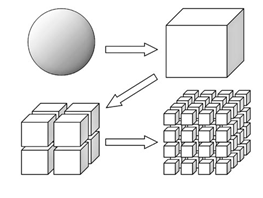
Mineral
composition-
some minerals are more resistant than others.
ex.: Quartz is resistant to chemical and physical weathering.
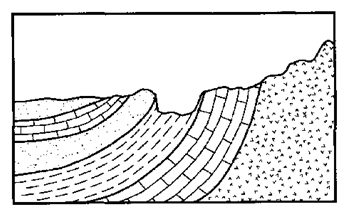
In the diagram above the different layers of the rock are weathered at different rates depending on the minerals within the rock. The layers sticking up most are the most resistant.
Soil - The product of weathering
Soil is made from rocks, minerals (mainly sand and clay),
and organic material (regolith and organic matter)
III Erosion
Erosion- the process of moving sediment from one location to another.
The most important FORCE of erosion is GRAVITY. The most important AGENT of erosion is WATER.
The amount of erosion by a stream depends on the velocity and volume of water flow.
Velocity is influenced by the slope & volume of a stream.
As the velocity increases the size of the particles transported will get bigger.

Volume (amount of water flowing) is influenced by
rainfall.
The shape of a stream will determine where erosion will occur. The fastest water
goes to the outside of the curve. The outside curve gets eroded away.
In a straight run of water, the fastest water runs above center of the stream.
The rate of erosion increases where the velocity increases. (Direct
Relationship)


Erosion Reading
If you've ever had the privilege of traveling to foreign countries or even
across the
Erosion happens when running water, sea waves, wind, or glaciers pick up
materials from the Earth's surface and carry them to other locations. The
actions of erosion and deposition work together to alter existing landforms and
create new ones. Deposition occurs when silt, sand and other materials are
carried by flowing water and deposited at other places on the Earth's surface.
Moving waters, such as rivers and streams, are the most important natural agents
of erosion. Whenever it rains, water washes over the land, picks up loose soil,
and carries it away. Water also washes weathered rocks (rocks altered through a
process called weathering) into rivers and streams. We'll learn more about how
weathering impacts the erosion process in Part 2 of "The Ever-changing Surface
of the Earth."
Gravitational pull plays a major role in the process of erosion and can cause
huge amounts of soil or rock debris to be carried down a slope, such as in the
case of a mudslide. This occurrence is referred to as a mass movement. Another
type of mass movement is when certain areas of the Earth's surface are pulled by
gravity and sink below ground level.
Erosion by Rivers
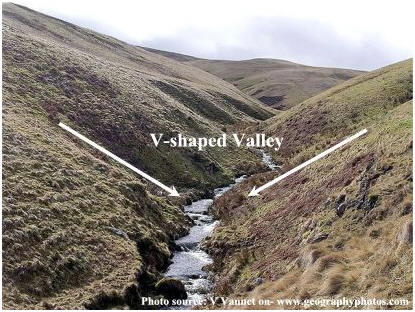
Here is a V-shaped valley? In this picture, where is the water moving at the fastest rate? ______________________________________________
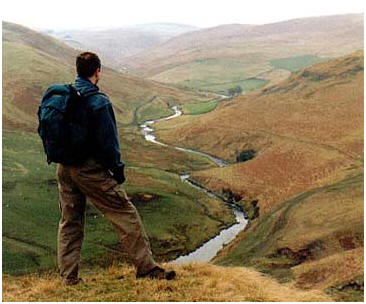
In the meandering stream, label the locations where erosion is taking place.
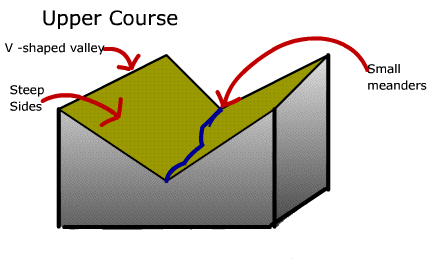
This is how water erodes land.
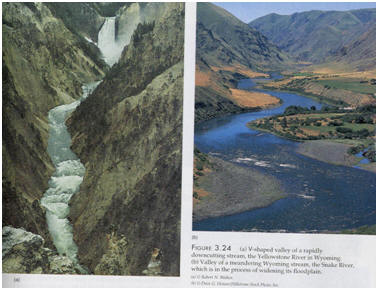
Another example of how rivers erode land.

The NYC Science Performance Standards
Standard 6 Key Idea 1. Through systems thinking people can recognize the commonalities that exist among all systems and how parts of a system interrelate and combine to perform specific functions.